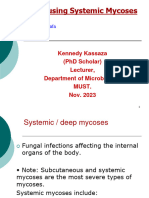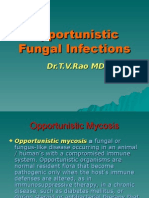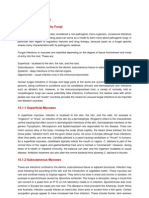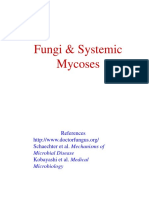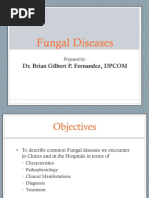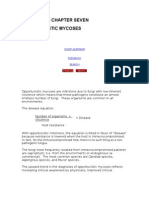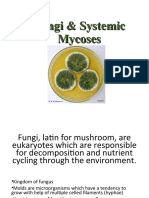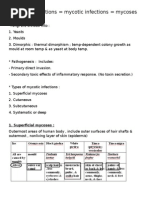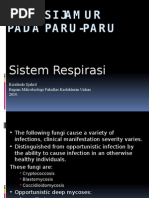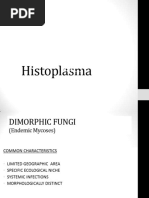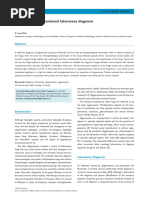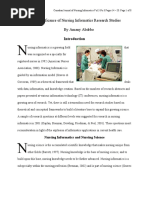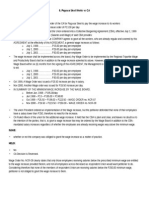0 ratings0% found this document useful (0 votes)
28 viewsFungal Infections of The Lower Respiratory Tract Disease Additional Information
Fungal Infections of The Lower Respiratory Tract Disease Additional Information
Uploaded by
AnnahFungal infections of the lower respiratory tract and skin can have varying severity. Coccidioidomycosis causes respiratory infection and can disseminate throughout the body if not treated. Histoplasmosis is a systemic infection that usually affects the lungs and is common in the Mississippi River valley. Pneumocystis pneumonia is an acute lung infection found in immunosuppressed patients like those with AIDS. Dermatophytoses like ringworm are fungal skin infections transmitted by direct contact with infected humans, animals, or contaminated objects.
Copyright:
© All Rights Reserved
Available Formats
Download as DOCX, PDF, TXT or read online from Scribd
Fungal Infections of The Lower Respiratory Tract Disease Additional Information
Fungal Infections of The Lower Respiratory Tract Disease Additional Information
Uploaded by
Annah0 ratings0% found this document useful (0 votes)
28 views2 pagesFungal infections of the lower respiratory tract and skin can have varying severity. Coccidioidomycosis causes respiratory infection and can disseminate throughout the body if not treated. Histoplasmosis is a systemic infection that usually affects the lungs and is common in the Mississippi River valley. Pneumocystis pneumonia is an acute lung infection found in immunosuppressed patients like those with AIDS. Dermatophytoses like ringworm are fungal skin infections transmitted by direct contact with infected humans, animals, or contaminated objects.
Original Title
fungal
Copyright
© © All Rights Reserved
Available Formats
DOCX, PDF, TXT or read online from Scribd
Share this document
Did you find this document useful?
Is this content inappropriate?
Fungal infections of the lower respiratory tract and skin can have varying severity. Coccidioidomycosis causes respiratory infection and can disseminate throughout the body if not treated. Histoplasmosis is a systemic infection that usually affects the lungs and is common in the Mississippi River valley. Pneumocystis pneumonia is an acute lung infection found in immunosuppressed patients like those with AIDS. Dermatophytoses like ringworm are fungal skin infections transmitted by direct contact with infected humans, animals, or contaminated objects.
Copyright:
© All Rights Reserved
Available Formats
Download as DOCX, PDF, TXT or read online from Scribd
Download as docx, pdf, or txt
0 ratings0% found this document useful (0 votes)
28 views2 pagesFungal Infections of The Lower Respiratory Tract Disease Additional Information
Fungal Infections of The Lower Respiratory Tract Disease Additional Information
Uploaded by
AnnahFungal infections of the lower respiratory tract and skin can have varying severity. Coccidioidomycosis causes respiratory infection and can disseminate throughout the body if not treated. Histoplasmosis is a systemic infection that usually affects the lungs and is common in the Mississippi River valley. Pneumocystis pneumonia is an acute lung infection found in immunosuppressed patients like those with AIDS. Dermatophytoses like ringworm are fungal skin infections transmitted by direct contact with infected humans, animals, or contaminated objects.
Copyright:
© All Rights Reserved
Available Formats
Download as DOCX, PDF, TXT or read online from Scribd
Download as docx, pdf, or txt
You are on page 1of 2
Fungal Infections of the Lower Respiratory Tract
DISEASE ADDITIONAL INFORMATION
Coccidioidomycosis (Valley Fever). Coccidioidomycosis Pathogen. Coccidioidomycosis is caused by Coccidioides immitis, a
starts as a respiratory infection, with fever, chills, cough, dimorphic fungus. It exists as a mould in soil and on culture media
and, rarely, pain. The primary infection may heal (25°C), where it produces arthrospores (arthroconidia). In tissues, it
completely or may progress to the disseminated form of the appears as spherical yeast cells called spherules that reproduce by
disease, which is often fatal. Disseminated endospore formation. C. immitis arthrospores have potential use as a
coccidioidomycosis may include lung lesions and bioterrorist agent.
abscesses throughout the body, especially in Reservoirs and Mode of Transmission. Arthrospores are present in
subcutaneous tissues, skin, bone, and the central nervous soil in arid and semiarid areas of the Western Hemisphere; in United
system. Other tissues and organs, such as inguinal lymph States, from California to southern Texas; and in Mexico, Central
nodes, kidneys, thyroid gland, heart, pituitary gland, America, and South America. Transmission occurs by inhalation of
esophagus, and pancreas, may also be involved. arthrospores, especially during wind and dust storms. It is not directly
Patient Care. Use Standard Precautions for hospitalized transmissible person to person or animal to person.
patients with draining lesions or pneumonia. Laboratory Diagnosis. Coccidioidomycosis is diagnosed by direct
examination and culturing of sputum, pus, urine, cerebrospinal fluid, or
biopsy materials. The mould form is highly infectious. All work must be
performed in a biosafety level (BSL)-2 or BSL-3 facility (refer to
CDROM Appendix 4). Skin tests, molecular diagnostic procedures,
and immunodiagnostic procedures are also available.
Cryptococcosis. Cryptococcosis starts as a lung infection,
but usually spreads via the bloodstream to the brain. The
disease is described later in the chapter, in the section
entitled “Fungal Infections of the Central Nervous System.”
Histoplasmosis. Histoplasmosis is a systemic mycosis of Pathogen. Histoplasmosis is caused by Histoplasma capsulatum var.
varying severity, ranging from asymptomatic to acute to capsulatum, a dimorphic fungus that grows as a mould in soil and as a
chronic. The primary lesion is usually in the lungs. The yeast in animal and human hosts (refer back to Fig. 5-13 in Chapter
acute disease involves malaise, fever, chills, headache, 5).
myalgia, chest pains, and a nonproductive cough (i.e., Reservoirs and Mode of Transmission. Reservoirs include warm,
sputum is not produced). Histoplasmosis is the most moist soil containing a high organic content and bird droppings,
common systemic fungal infection in AIDS patients. especially chicken droppings, but also bat droppings in caves and
Patient Care. Use Standard Precautions for hospitalized around starling, blackbird, and pigeon roosts. Transmission occurs via
patients. inhalation of conidia (asexual spores) from soil. Bulldozing and
excavation may produce aerosols of spores. Histoplasmosis is the
most common systemic fungal disease in the United States, occurring
primarily in the Ohio, Mississippi, and Missouri River valleys.
Histoplasmosis is not transmitted from person to person.
Laboratory Diagnosis. H. capsulatum yeasts may be observed in
Giemsa- or Wright-stained smears of ulcer exudates, bone marrow,
sputum, and blood. H. capsulatum produces mould colonies when
incubated at room temperature and yeast colonies when incubated at
body temperature. Conversion from the mould form to the yeast form
can sometimes be accomplished in the laboratory. Skin tests and
immunodiagnostic procedures are available.
Pneumocystis Carinii Pneumonia (PCP, Interstitial Pathogen. The etiologic agent of PCP is Pneumocystis jiroveci
Plasma-Cell Pneumonia). PCP is an acute-to-subacute (formerly P. carinii). This organism has both protozoal and fungal
pulmonary disease found in malnourished, chronically ill properties. It was classified as a protozoan for many years, but is
children; premature infants; and immunosuppressed currently classified as a nonfilamentous fungus.
patients, such as those with AIDS. Patients have fever, Reservoirs and Mode of Transmission. Infected humans serve as
difficulty in breathing, rapid breathing, dry cough, cyanosis, reservoirs. The mode of transmission is unknown—perhaps direct
and pulmonary infiltration of alveoli with frothy exudate. contact, perhaps transfer of pulmonary secretions from infected to
PCP is usually fatal in untreated immunosuppressed susceptible persons, perhaps airborne.
patients. It is a common contributory cause of death in Laboratory Diagnosis. Diagnosis of PCP is made by demonstration
AIDS patients. Pneumocystis causes an asymptomatic of Pneumocystis in material from bronchial brushings, open lung
infection in immunocompetent people. Patient Care. Use biopsy, lung aspirates, or smears of tracheobronchial mucus by
Standard Precautions for hospitalized patients. Do not various staining methods. P. jiroveci cannot be cultured.q
place PCP patients in the same room with an
immunocompromised patient.
Pulmonary Zygomycosis. The term zygomycosis Pathogens. Many different fungi can cause zygomycosis, including
(formerly mucormycosis or phycomycosis) refers to a some that are often referred to as bread moulds. These fungi, which
disease caused by one of the many fungi in the class include species of Mucor, Rhizopus, and Absidia, are responsible for
Zygomycetes. These fungi are widely distributed in soil and the white or gray fuzzy growth seen on foods such as bread and
vegetative matter. Although being discussed in the section cheese. The fuzziness is the result of aerial hyphae.
on lower respiratory diseases, these fungi cause diseases Reservoirs and Modes of Transmission. Most commonly, humans
with a wide range of clinical manifestations. Other clinical become infected with zygomycetes by inhaling airborne spores,
syndromes caused by members of the Zygomycetes class although ingestion and direct inoculation through traumatic breaks in
include sinusitis, cerebral infection, cutaneous disease, the skin and mucous membranes can also lead to infection.
gastrointestinal disease, and disseminated disease, which Zygomycosis is not transmitted from person to person.
involve virtually every organ. Laboratory Diagnosis. Diagnosis of zygomycosis can be made by
Patient Care. Use Standard Precautions. microscopic observation of distinctive, ribbonlike, broad, aseptate
hyphae in tissue sections and by culture of biopsy tissue.
FUNGAL INFECTIONS OF THE SKIN
Disease Additional Information
Dermatophytoses Dermatophytoses are also known as tinea Pathogens. Dermatomycoses are caused by various filamentous fungi
(ringworm) infections and dermatomycoses. (moulds), collectively referred to as dermatophytes. Examples include
Diseases. (See preceding sections on superficial and cutaneous species of Microsporum, Epidermophyton, and Trichophyton.
mycoses.) Some of the dermatomycoses cause only limited irritation,
scaling, and redness. Others cause itching, swelling, blisters, and Reservoirs and Mode of Transmission. Infected humans and animals and
severe scaling. soil serve as reservoirs. Transmission is by direct or indirect contact with
lesions of humans or animals; or contact with contaminated floors, shower
Patient Care. Use Standard Precautions. stalls, or locker room benches; barbers’ clippers, combs, and hairbrushes; or
clothing.
Laboratory Diagnosis. Microscopic examination of potassium hydroxide
(KOH) preparations of skin scrapings or hair or nail clippings can reveal the
presence of fungal hyphae (The KOH preparation is described in CD-ROM)
Dermatophytes can be cultured on various media, including Sabouraud
dextrose agar. Moulds are identified using a combination of macroscopic
and microscopic observations
FUNGAL INFECTIONS OF THE ORAL REGION
Disease Additional Information
Thrush Disease. Thrush is a yeast infection of the oral cavity. It is Pathogens. The yeast, C. albicans and related species.
common in infants, elderly patients, an immunosuppressed individuals.
White, creamy patches occur on the tongue, mucous membranes, and Reservoir and Mode of Transmission. Infected humans serve as
the corners of the mouth Thrush can be a manifestation of reservoirs. Transmission occurs by contact with secretions or excretions of
disseminated Candidainfection (candidiasis). Candida albicans is the mouth, skin, vagina, or feces of patients or carriers; also by passage from
yeast and the fungus most commonly isolated from clinical specimens mother to neonate during childbirth and by
— sometimes isolated as a pathogen and sometimes isolate endogenous spread (i.e., from one area of the body to another).
Laboratory Diagnosis. Thrush can be diagnosed by observation of yeast
cells and pseudohyphae (strings of elongated buds) in microscopic
examination of wet mounts, and by culture confirmation
FUNGAL INFECTIONS OF THE GENITOURINARY SYSTEM
Disease Additional Information
Yeast Vaginitis Disease. The three most common causes of vaginitis Pathogens. The yeast, C. albicans, causes about 85% to 90% of yeast
in the United States, each causing about one third of the cases, are C. vaginitis; other Candida spp. can also cause this disease.
albicans (a yeast), Trichomonas vaginalis (a protozoan), and a mixture
of bacteria (including bacteria in the genera Mobiluncus and Reservoir and Mode of Transmission. (See previous section on
Gardnerella). A saline wet mount preparation is usually used to “Thrush.”)
diagnose vaginitis; this test procedure is described in CD-ROM
Appendix 5. Typical symptoms of yeast vaginitis are vulvar pruritis Laboratory Diagnosis. Yeast vaginitis can be diagnosed by microscopic
(itching), a burning sensation, dysuria, and a white discharge. Vulvar examination of a saline wet mount of vaginal discharge material, in which
erythema (redness) and rash sometimes occur. yeasts and hyphae may be observed. The vaginal discharge material
should also be cultured. Candida spp. grow well on blood agar and
Sabouraud dextrose agar. Candidaspp. can usually be identified using a
commercial yeast identification minisystem. It is important to keep in mind
that the vaginal microflora of up to 25% of healthy women can contain
Candida spp.
FUNGAL INFECTIONS OF THE CENTRAL NERVOUS SYSTEM
Disease Additional Information
Cryptococcosis (Cryptococcal Meningitis) Disease. Cryptococcosis Pathogens. Cryptococcosis can be caused by three subspecies of C.
starts as a lung infection, but spreads via the bloodstream to the brain. It neoformans, an encapsulated yeast The capsule enables C. neoformans
usually presents as a subacute or chronic meningitis. Infection of the to adhere to mucosal surfaces and avoid phagocytosis by white blood
lungs, kidneys, prostate, skin, and bone may also occur. Cryptococcosis is cells.
a common infection in acquired immunodeficiency syndrome (AIDS)
patients. Reservoirs and Modes of Transmission. Reservoirs include pigeon
nests; pigeon, chicken, turkey, and bat droppings; and soil contaminated
Patient Care. Use Standard Precautions for hospitalized patients. with bird droppings. Growth of C. neoformans is stimulated by the
alkaline pH and high nitrogen content of bird droppings. Transmission
occurs by inhalation of yeasts, often projected into the air by sweeping or
excavation. Cryptococcus is not transmitted from person to person or
animal to person.
Laboratory Diagnosis. Cryptococcal meningitis is often diagnosed by
observing encapsulated, budding yeasts in cerebrospinal fluid
specimens examined by an India ink preparation. (Details of the India ink
preparation can be found in CD-ROM Appendix 5, Clinical Microbiology
Laboratory Procedures.) Yeasts may also be observed in sputum, urine,
and pus examined by an India ink preparation or Gram stain C.
neoformanscan be cultured on routine media used in the Mycology
Section. A sensitive Cryptococci antigen detection test is available.
You might also like
- Primary Secondary Tillage Equipment PDFDocument13 pagesPrimary Secondary Tillage Equipment PDFГарпия Сова100% (2)
- Dessert Business Plan1 PDFDocument155 pagesDessert Business Plan1 PDFAnnahNo ratings yet
- DNV Rules For Electrical Instal at IonsDocument80 pagesDNV Rules For Electrical Instal at Ionsnzjohn100% (3)
- Interpretation of Geophysical Logs Coal.Document16 pagesInterpretation of Geophysical Logs Coal.Thamzez Nur AnomNo ratings yet
- systemic mycoses assignmentDocument3 pagessystemic mycoses assignmentsaad SohailNo ratings yet
- Mycotic InfectionDocument22 pagesMycotic InfectionDevanshi Kulkarni100% (1)
- Jamur: Blok Mekanisme Dasar Penyakit Departemen MikrobiologiDocument57 pagesJamur: Blok Mekanisme Dasar Penyakit Departemen MikrobiologiRachel JohnsonNo ratings yet
- Day 9 Mycology & Applied January 2021Document338 pagesDay 9 Mycology & Applied January 2021ShriefElghazalyNo ratings yet
- Prof. Efrida MYCOSIS SYSTEMIKDocument48 pagesProf. Efrida MYCOSIS SYSTEMIKadityaNo ratings yet
- Mycosis Systemik - Blok TID - Feb 2015Document67 pagesMycosis Systemik - Blok TID - Feb 2015Kiki Celiana TiffanyNo ratings yet
- Lecture Systemic Mycosis 23-11-2023 KK-1Document128 pagesLecture Systemic Mycosis 23-11-2023 KK-1David lufafaNo ratings yet
- Jamur Pada Traktus Respiratorius Asaad Aaa 06 012Document58 pagesJamur Pada Traktus Respiratorius Asaad Aaa 06 012Muhammad Satir SayatiNo ratings yet
- Systemic MycosesMDocument43 pagesSystemic MycosesMMaxamed Faarax XaashiNo ratings yet
- 03 Histoplasmosis999Document42 pages03 Histoplasmosis999singhak1999poNo ratings yet
- Systemic MycosesDocument22 pagesSystemic Mycosesrossm0081No ratings yet
- Opportunistic Fungal InfectionsDocument81 pagesOpportunistic Fungal Infectionstummalapalli venkateswara raoNo ratings yet
- Opportunistic MycosisDocument59 pagesOpportunistic MycosisSisay Fesseha AmbayeNo ratings yet
- Systemic MycosesDocument20 pagesSystemic MycosesBurhan JavaidNo ratings yet
- 03 HistoplasmosisDocument43 pages03 Histoplasmosisdakayiivan642No ratings yet
- 15 Pathogenic FungiDocument8 pages15 Pathogenic FungiSathish KumarNo ratings yet
- PHM242 Fungi H.SaedDocument78 pagesPHM242 Fungi H.Saedjagbirshoker102No ratings yet
- Fungal Diseases 1Document33 pagesFungal Diseases 1rexamomosNo ratings yet
- True Systemic (Endemic) MycosesDocument6 pagesTrue Systemic (Endemic) MycosesKoni Oroceo-SacramedNo ratings yet
- Diagnostic Microbiology - : University of Santo Tomas - Medical TechnologyDocument6 pagesDiagnostic Microbiology - : University of Santo Tomas - Medical TechnologyWynlor AbarcaNo ratings yet
- CH 06 FinalDocument27 pagesCH 06 Finalkhoalamsang123No ratings yet
- 3b. Fungi ZugerDocument27 pages3b. Fungi Zugerbintang25No ratings yet
- Anti-Fungal Drugs - Summer 2023Document60 pagesAnti-Fungal Drugs - Summer 2023NAYEEMA JAMEEL ANUVANo ratings yet
- Systemic MycosesDocument9 pagesSystemic MycosesNeed IsolationNo ratings yet
- Infectious Disease Mycology: DR - Kedar KarkiDocument42 pagesInfectious Disease Mycology: DR - Kedar KarkiDr.Kedar Karki ,M.V.Sc.Preventive Vet.Medicine CLSU Philippines100% (1)
- IDS QuizDocument163 pagesIDS Quizd99452727No ratings yet
- Systemic Mycoses: DR John EgbagbaDocument78 pagesSystemic Mycoses: DR John EgbagbaPrincewill SeiyefaNo ratings yet
- Fungal Mycosis and Other InfectionsDocument34 pagesFungal Mycosis and Other InfectionsRajeev PotadarNo ratings yet
- Share FUNGAL DISEASES. IDSDocument65 pagesShare FUNGAL DISEASES. IDSdairymilk.weNo ratings yet
- University of Santo Tomas - Medical Technology Diagnostic MicrobiologyDocument5 pagesUniversity of Santo Tomas - Medical Technology Diagnostic Microbiologythedarkwing100% (1)
- Systemic MycosisDocument4 pagesSystemic Mycosisredrose98765.comNo ratings yet
- Mycology - Chapter Seven Opportunistic Mycoses: Let Us Know What You ThinkDocument9 pagesMycology - Chapter Seven Opportunistic Mycoses: Let Us Know What You ThinkAreeqa AliNo ratings yet
- Fungi & Systemic MycosesDocument49 pagesFungi & Systemic MycosesAmal ShereefNo ratings yet
- Mycotic Infectios of The Oral CavityDocument45 pagesMycotic Infectios of The Oral CavityoladunniNo ratings yet
- Fungal Infections in Diabetes Mellitus: An Overview: Review ArticleDocument5 pagesFungal Infections in Diabetes Mellitus: An Overview: Review ArticleAudrey Ira YunitaNo ratings yet
- Lecture 2 On FUNGAL INFECTIONSDocument49 pagesLecture 2 On FUNGAL INFECTIONSAMIT GUPTANo ratings yet
- Subcutaneous MycosesDocument3 pagesSubcutaneous MycosesiwennieNo ratings yet
- Yersinis SPP & Pasturella SPP - Jkt..2023Document45 pagesYersinis SPP & Pasturella SPP - Jkt..2023alicerugaibula123No ratings yet
- What Is Subcutaneous MycosesDocument4 pagesWhat Is Subcutaneous MycosesArslan SaeedNo ratings yet
- 04 Systemic MycosesDocument62 pages04 Systemic MycosesFelix AyornuNo ratings yet
- Presterl 2018Document5 pagesPresterl 2018lakshman kumarNo ratings yet
- There Is No Information Available at This TimeDocument3 pagesThere Is No Information Available at This Timekylrn1No ratings yet
- Systemic FungiDocument28 pagesSystemic FungiFarah Krisna Sadavao AndangNo ratings yet
- Fungal Infections Mycotic Infections MycosesDocument12 pagesFungal Infections Mycotic Infections MycosesHussein QasimNo ratings yet
- Infeksi Jamur Pada Paru-ParuDocument29 pagesInfeksi Jamur Pada Paru-ParuSuhud Dwi WahyudiNo ratings yet
- Report Microb1Document14 pagesReport Microb1edengayp29No ratings yet
- L5 - Histoplsamosis and Endemic MycosisDocument33 pagesL5 - Histoplsamosis and Endemic Mycosisdvph2fck6qNo ratings yet
- Groupone MycologyDocument14 pagesGroupone MycologyTilahun TesemaNo ratings yet
- Fungi & Systemic MycosesDocument42 pagesFungi & Systemic MycosesariffdrNo ratings yet
- Fungal MicrobiologyDocument10 pagesFungal MicrobiologyGrace joy DoocNo ratings yet
- 9 (Mycology + Parasitology) F 24Document30 pages9 (Mycology + Parasitology) F 24irccNo ratings yet
- Samenvatting Infectie en InflammatieDocument169 pagesSamenvatting Infectie en InflammatiejeskevandiemenNo ratings yet
- Opportunistic Mycoses: Yeasts: Candida SPP., Cryptococcus Spp. Mycelial or Filamentous FungiDocument10 pagesOpportunistic Mycoses: Yeasts: Candida SPP., Cryptococcus Spp. Mycelial or Filamentous FungiSSJ GAMERNo ratings yet
- W11.Chap.316.Endemic MycosisDocument11 pagesW11.Chap.316.Endemic MycosisJessica CarvajalNo ratings yet
- 18 - The Fungal Nfections of HumansDocument56 pages18 - The Fungal Nfections of HumansguangcorenzvmdNo ratings yet
- 1 s2.0 S1198743X1460731X MainDocument6 pages1 s2.0 S1198743X1460731X Mainymawarti2021No ratings yet
- Kuliah Jamur FKMDocument90 pagesKuliah Jamur FKMichaNo ratings yet
- 7-Mycology. 28.1.2024Document9 pages7-Mycology. 28.1.2024Ayob AlarabiNo ratings yet
- 911 Pigeon Disease & Treatment Protocols!From Everand911 Pigeon Disease & Treatment Protocols!Rating: 4 out of 5 stars4/5 (1)
- Transform BoundaryDocument1 pageTransform BoundaryAnnahNo ratings yet
- Business Model: Place No. of Staff Raw Materials (Ingredients) January Week 1 Week 2 Week 3Document6 pagesBusiness Model: Place No. of Staff Raw Materials (Ingredients) January Week 1 Week 2 Week 3AnnahNo ratings yet
- Play Like MeDocument5 pagesPlay Like MeAnnahNo ratings yet
- MY THOUGHTS ABOUT "A Beautiful Mind": Daro, Farhannah T. Bsn-3Document1 pageMY THOUGHTS ABOUT "A Beautiful Mind": Daro, Farhannah T. Bsn-3AnnahNo ratings yet
- A.) Culture and Its Role in Moral BehaviourDocument6 pagesA.) Culture and Its Role in Moral BehaviourAnnahNo ratings yet
- Vitamins: Biochemical Roles: Biochemistry 3070Document38 pagesVitamins: Biochemical Roles: Biochemistry 3070AnnahNo ratings yet
- Antifungal Agents: Vectors Disease (S)Document4 pagesAntifungal Agents: Vectors Disease (S)AnnahNo ratings yet
- Acyclovir (Acycloguanosi Ne) : Systemic Administration History: AllergyDocument3 pagesAcyclovir (Acycloguanosi Ne) : Systemic Administration History: AllergyAnnahNo ratings yet
- Laboratory and Diagnostic ResultsDocument3 pagesLaboratory and Diagnostic ResultsAnnahNo ratings yet
- Case Study SUBJECTIVE CUESDocument5 pagesCase Study SUBJECTIVE CUESAnnahNo ratings yet
- Nursing Care Plan Assessment Diagnosis Planning Intervention Rationale EvaluationDocument5 pagesNursing Care Plan Assessment Diagnosis Planning Intervention Rationale EvaluationAnnahNo ratings yet
- Basketball InjuriesDocument3 pagesBasketball InjuriesAnnahNo ratings yet
- Nursing Care PlanDocument3 pagesNursing Care PlanAnnahNo ratings yet
- Significance of Nursing Informatics Research Studies by Amany AbdrboDocument8 pagesSignificance of Nursing Informatics Research Studies by Amany AbdrboAnnahNo ratings yet
- VECTORSDocument1 pageVECTORSAnnahNo ratings yet
- Lesson 4: Utilitarianism: Jeremy Bentham Is Known As TheDocument8 pagesLesson 4: Utilitarianism: Jeremy Bentham Is Known As TheAnnahNo ratings yet
- Lesson 4: Utilitarianism: Jeremy Bentham Is Known As TheDocument8 pagesLesson 4: Utilitarianism: Jeremy Bentham Is Known As TheAnnahNo ratings yet
- Ethics ScriptDocument5 pagesEthics ScriptAnnahNo ratings yet
- 101 ConclusionDocument2 pages101 ConclusionAnnahNo ratings yet
- Maryam Akhlaq - IDI GuideDocument3 pagesMaryam Akhlaq - IDI GuideMaryam AkhlaqNo ratings yet
- The Advantages and Disadvantages of Self Learning Especially in Senior High School StudentsDocument19 pagesThe Advantages and Disadvantages of Self Learning Especially in Senior High School Studentsnovajoesge guillermoNo ratings yet
- The Significance of Water Level Indicator AlarmDocument6 pagesThe Significance of Water Level Indicator Alarmjudea.tomajinNo ratings yet
- WaterFlood PDFDocument16 pagesWaterFlood PDFTheNourEldenNo ratings yet
- Developmental Theories and Other Relevant Theories: Vygotsky'S Socio-Cultural Theory Kohlberg'S Stages of Moral DevelopmentDocument5 pagesDevelopmental Theories and Other Relevant Theories: Vygotsky'S Socio-Cultural Theory Kohlberg'S Stages of Moral DevelopmentDarlene Dacanay DavidNo ratings yet
- The Vivekanand School: Annual ExaminationDocument4 pagesThe Vivekanand School: Annual Examinationchaitanya goyalNo ratings yet
- Ben Lynch Questionnaire 1Document2 pagesBen Lynch Questionnaire 1Vijay Bantu100% (1)
- Blue Book 2016 17 PDFDocument60 pagesBlue Book 2016 17 PDFPSmNo ratings yet
- Pag-Asa Steel Works Vs CADocument1 pagePag-Asa Steel Works Vs CAida_chua8023No ratings yet
- Noise Module3Document54 pagesNoise Module3Debi prasad DasNo ratings yet
- Electrochemistry Test Bank (Part 1)Document33 pagesElectrochemistry Test Bank (Part 1)sunydayformeNo ratings yet
- MFRS 137 - Tutorial QuestionsDocument19 pagesMFRS 137 - Tutorial QuestionsN FrzanahNo ratings yet
- Anlau@mit - Edu: BIOS E-16/W: Cell Biology Harvard Extension School, Spring 2016 InstructorsDocument3 pagesAnlau@mit - Edu: BIOS E-16/W: Cell Biology Harvard Extension School, Spring 2016 InstructorsEnriqueCarlosNo ratings yet
- Marketing Chapter4Document27 pagesMarketing Chapter4Angel Bengan100% (1)
- Sabar 1Document9 pagesSabar 1NAZWA SALSABILLAHNo ratings yet
- Assignment-Value Proposition Canvas (2-2)Document7 pagesAssignment-Value Proposition Canvas (2-2)Ntirenganya EzechiasNo ratings yet
- 03 Entropy NotesDocument16 pages03 Entropy Notessaramnbv2No ratings yet
- "Simple Screening Test of Ampc Beta-Lactamases in Clinical Isolates Among MultidrugDocument15 pages"Simple Screening Test of Ampc Beta-Lactamases in Clinical Isolates Among MultidrugBhagwat Suryawanshi100% (1)
- 12 A MouldingDocument35 pages12 A Mouldingshreeghadage7No ratings yet
- Mopw Electrical Load ScheduleDocument124 pagesMopw Electrical Load ScheduleRodel D DosanoNo ratings yet
- Insurance Law - CausationDocument28 pagesInsurance Law - CausationRosary BeadesNo ratings yet
- Advocacy SpeechDocument2 pagesAdvocacy SpeechJim Charles M. MoralesNo ratings yet
- Chapter 1Document20 pagesChapter 1Taiyaki Đậu ĐỏNo ratings yet
- 41 LRM10V4Document2 pages41 LRM10V4RamachandranVenkatNo ratings yet
- 5.antihypertensive DrugsDocument63 pages5.antihypertensive Drugskumbirai Gladys MandavaNo ratings yet
- Red-Ox Titrations, Permanganometry, Iodometry Etc.: Pabitra Kumar ManiDocument32 pagesRed-Ox Titrations, Permanganometry, Iodometry Etc.: Pabitra Kumar ManiJeffrey RamosNo ratings yet
- 00000102Document108 pages00000102Scary CreaturesNo ratings yet










